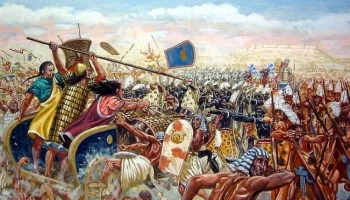Ericka S. Dunbar is Ph.D. candidate in the area of Hebrew Bible at Drew University (Madison, NJ, USA). Her dissertation project is entitled, “Trafficking Hadassah: An Africana Reading of Collective Trauma, Memory and Identity in the Book of Esther”. In her project, Ericka places the biblical story of Esther in conversation with the sexual exploitation of African diasporian subjects during the transatlantic slave trade in order to investigate the intersections and consequences of sexual exploitation of minority girls and women across time and contexts and, in order to assess the impact of collective, intergenerational and cultural trauma on identity and memory. Her teaching and research interests include: Religion and Social Change; Africana Biblical Studies, Africana Diaspora Studies, Trauma, Studies, Ethics, Cultural Studies, Women’s Studies, gender-based violence, women and children in the Bible, Human Trafficking discourses, the role and impact of religion on individual and collective/cultural identities.
For Such a Time as This? #UsToo: Sexual Trafficking, Silence, & Secrecy in the Book of Esther
Not all silence sounds the same. Some silence is, well … quiet. Other silence is deafening. The silence around sexual trafficking and the hyper-invisibility of victims of trafficking is deafening … striking …. disturbing. Silence is also what allows trafficking and exploitation to thrive. It plays its part in systemic oppression, perpetuating suffering, diminishing agency, limiting mobility. Yet silence is disruptive and it is vocal! If only we would listen to the quiet screams, the hushed pleas, petitioning us, “see me, hear me, protect me, advocate for me!” Attention to the silences in both biblical texts and contemporary contexts can and should disrupt normative modes of interpretation, illuminating traumatization and psychological truths that have gone unvoiced for far too long.
There are troubling silences in the book of Esther that have been muted and ignored throughout the history of interpretation. The book of Esther presents representations of collective trauma in the form of sexual trafficking. In the second chapter of the book of Esther, the female collective includes Esther and countless virgin girls who are trafficked by the Persian King Ahasuerus and his officials.
Sexual trafficking is “the recruitment, transportation, transfer, harbor, or receipt of people, by coercive or abusive means for the purpose of sexual exploitation.”[i] It is right there in the book of Esther where the king’s servants suggest the following:
Let beautiful young virgins be sought out for the king. And let the king appoint commissioners in all the provinces of his kingdom to gather all the beautiful young virgins to the harem in the citadel of Susa under custody of Hegai, the king’s eunuch, who is in charge of the women; let their cosmetic treatments be given them. And let the girl who pleases the king be queen instead of Vashti. (2:2b-2:4a)
The failure of readers to identify and/or perceive recruitment, transportation, and harboring of subjects in the biblical text as characteristics of trafficking prevents them from expressing outrage and from taking action. Esther and other virgin girls are abducted from their native lands, which span from India to Ethiopia (1:1), are transported to Persia and held captive in the king’s palace so that he can engage in nonconsensual sex with each of them until he determines which one satisfies him best sexually. These vulnerable girls are seized, brought against their wills, and secluded in the king’s palace, all elements of trafficking. They are transported from their home provinces, harbored in the king’s harems, undergo a beautification/ preparation process (which includes pampering and perfuming for a year), and repeatedly sexually abused, night after night. What stands out to me is that the girls in the narrative world are taken from provinces that are inhabited predominately by brown and black minorities in our contemporary contexts. Further, brown and black females are disproportionately vulnerable to and targeted by traffickers. I believe that our understandings of sexual trafficking in contemporary contexts illuminate trafficking in this ancient sacred text.
Historically, biblical interpreters frame the exploitation of the “virgin girls” as a harmless, even “fun,” beauty pageant. Defining the exploitation as a “beauty contest,” however, ignores the elements of capture, captivity, and forced displacement and prevents the analysis of such experiences as exploitative and trauma- inducing trafficking. Perhaps understanding the various parties as involved in trafficking will better illuminate the process of prolonged exploitation in the book of Esther. In trafficking, there are generally four parties involved in a transaction although not all four are necessary for the facilitation of abuse: the perpetrator, the vendor, the facilitator and the victim(s). The perpetrator, or the king, sexually exploits the victim(s). The vendor(s), or the king’s servants, extend the services/bodies/capital that make sexual trafficking possible. The facilitator(s), that is, the officers in the provinces of the king expedites the victimization process, and the victim(s) are the object of sexual exploitation: namely, the virgin girls. Attention to both the processes and parties involved in trafficking exposes the violence and horror of this text. The book of Esther is often read as comical, or as a celebration of a beautiful and clever heroine that ascends to queen – but such a reading does not tell the whole story as it obscures, suppresses and condones large-scale abuse in the form of trafficking women and girls.

Perpetrators, vendors, and facilitators of abuse depend on and capitalize off silence, suppressed voices, and secrecy. They weaponize our silence and use it to perpetuate the abduction and transportation of girls across national and international borders. Secrecy is a prominent theme in chapter 2 as Esther’s identity is kept a secret, Moreover, the identity and names of the numerous other virgin girls brought in two rounds remain obscured too. One might ask what role Esther’s guardian, Mordecai, plays in her exploitation and oppression as he orders her to maintain secrecy. The absence of the sound of the virgin girls’ voices leads to physical harm and perpetual psychological suffering. They are not allowed to protest their suffering neither do their male guardians protest their exploitation. The absence of protest is horrifying. Yet, if we pay attention to the words not spoken, or narrated in the case of the book of Esther, we’ll see that the muteness and silences throughout present soundless shrieks and inaudible stutters of throbbing hostility, paralyzing trauma, and shocking terror.
Collective trauma is experienced when groups share in catastrophic events that lead to suffering. Read closely, this story reflects the woundedness and torture of the female collective. They are confronted with displacement, subjection under imperial rule, and legalized gender oppression through the creation of hegemonic and sexist laws, exploitation, and rape. In the first chapter, in response to Vashti’s resistance to the king’s attempt to sexually exploit her, the female collective’s subjugation is legalized as the king’s advisors create the law that, “every man be master in his own household and speak according to the language of his people” (1:22). Women are victims of patriarchy and misogyny, become the property of the empire, and with the exception of Esther, disappear into the narrative world, never to have agency again in the biblical text. These experiences reflect those of girls and women captured, transported, and harbored on plantations during the transatlantic slave trade throughout the 16th to 19th centuries. They were raped and impregnated against their wills, beaten and killed if they attempted to resist in any way. Their enslaved male counterparts had similarly brutal fates.
Not surprisingly, the book of Esther fails explicitly to detail the female collectives’ responses to the horror they endure. However, I argue that silence here is a narrative device that reflects the traumatic impact of the horrors they endure. Silence is a feature of horror that often reflects a “numbing effect” of devastation. The absence of the women’s speech and the lack of narration of their emotional responses highlight how blistering these experiences are and reflect the physical and emotional toll on the girls. Their inaudible responses reflect the unutterable horrors they withstand. Instead of screaming voices, we are presented with and forced to focus on the spectacle of inaudible, dislocated, physically and psychologically injured and sexually transgressed bodies which shocks, arrests, and disgusts us as readers. These silences are and should be just as telling as audible screams.
Each time I read the text, the deposition of Vashti and of the graphic sexual imagery representing sexual trafficking, it arrests and terrifies me, especially when I consider the impact of this text in light of recent trends in trafficking and the global #MeToo movement. I am passionately concerned about abused and trafficked girls and women and I hope that by engaging the sacred texts, a hermeneutic of trauma and horror might aid us in our ability to confront the causes and consequences of trafficking. I hope that such a reading and hermeneutic may underscore the impact of sexual violence, terror, and traumatization on group identity, memory, and history. If we are to respond effectively to issues of trafficking and exploitation, we must transform the silence around trafficking and traumatization first. We must also illuminate the powerful impact of ancient – including biblical – cultures, ideologies, theologies and practices, particularly on such topics as sex trafficking and abuse, and we must engage in ethically responsible readings and interpretations of sacred texts, even, or especially if they are horrific. My interpretation of the book of Esther has the potential to galvanize us towards collective advocacy and action for vulnerable and exploited females across the globe.
Silence in texts and in our contemporary contexts should serve as a stimulus to investigate stories and expose suffering. After all, “Perhaps this is the moment for which [we] have been created” (Esther 4:4). Perhaps, this is the moment to sound off in solidarity for our sisters that have been silenced and oppressed. Perhaps this is the moment to shatter the silence and reclaim, “Not in My Name!”
#unspokentruths #stopnormalizingsilence #textsofterror #traffickingtraumatizes
[i] US Department of State, Trafficking in Persons Report (Washington, DC: US Department of State Publications, 2014), http://www.state.gov/j/tip/rls/tiprpt/2014/index.htm.
Black and white image titled ‘NOT For Sale’, courtesy of Ira Gelb, https://flic.kr/p/9xSTCc






